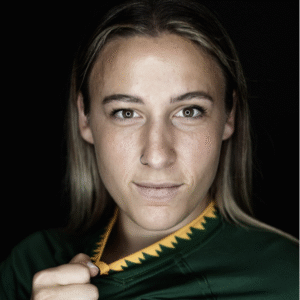HIT FOR SIX – When and where to watch the Cricket World Cup
Hot on the heels of the Rugby World Cup, we have cricket’s show piece event. Admittedly cricket sometimes struggles to shake its reputation as a boring ol’ sport for boring ol’ men. But that’s about to change. Clare McEwen tells you when and where to watch the Women’s Cricket World Cup and gives you a quick start guide if you’re new to the sport.
Embed from Getty ImagesIt is true that cricket in its longest format, the Test match, doesn’t appeal to everyone. Recognising that long, tactical battles limited the sport’s appeal, the governing body began to develop shorter and more exciting formats. Test matches are played over five days with the game relying on patience, tactics, and the weather! In the 1970s, the One Day International (known as an ODI) was first introduced as a faster-paced alternative. After some experimentation, in 1981 the event was standardised to 50 overs batted per side. This made it possible to fit the whole match into a single day, around 8 hours worth of cricket. Because of the limited overs, ODIs need a steady scoring rate throughout the game compared with the more cautious approach of Test matches. This makes them more exciting to watch since the action is condensed. The 2025 Women’s World Cup uses the ODI format.
The women’s ODI World Cup has been played since 1973. This, the 13th edition, will see the winners take a record £3.3m. This is more than Australia’s men got for winning their World Cup in 2023 (£2.96m), a clear indicator of how the ICC (International Cricket Council) is investing in the future of women’s cricket. This is, however, a recent change because the Australian women received a more modest £980,000 for winning in 2022. The total prize pot across the competition is nearly four times the amount it was three years ago. More history is being made as this is the first time the whole team of match officials are female.
Cricket quick start guide for newcomers to the sport
Two players bat at any one time. Batters can score by either whacking the ball to the boundary (the white rope round the edge of the grass) or running between the wickets. If the ball rolls over the boundary rope or bounces before it, four runs are scored, if it flies over the rope without bouncing, it’s six runs. Each team bats for 50 overs and tries to get as many runs as possible before 10 batters are got “out” by the bowling side (the 11th can’t bat on their own, so it’s only 10 batters).
The bowling team try to take “wickets” (same as getting batters out) as quickly as possible whilst limiting their ability to score runs. There are six balls in an over (each time a bowler chucks the ball down the pitch, it’s a “ball”). Bowlers can get batters out by directly hitting the wicket (the funny stick arrangement behind the batter), by catching the ball after it’s hit, running out a batter (hitting the sticks with the ball before the runner gets there), or by a more complicated method called LBW, short for leg before wicket. Getting out LBW involves various factors and if you watch for a bit, you’ll get a feel for what matters. Essentially it’s about the position of the leg when the ball hits it and whether the umpire (the referee) thinks the ball would have hit the wicket if the leg hadn’t been there. Technology today makes this easier to understand as the commentators talk you through it. It’s also fun predicting the decision. Bowlers bowl in different ways: some are fast and some use “spin” to make the ball wiggle around after hitting the ground. You’ll also hear commentators talk about “swing” which is how the ball moves through the air. Once all the first set of batters are out, the second batting team needs to score more than the first to win.
If that hasn’t put you off, read on to find out where, when, and who you should be watching.
Embed from Getty Images
When, where, and who
When: Tuesday 30th September to Sunday 2nd November 2025
Where: India and Sri Lanka are co-hosts
Teams (ODI ranking): Australia (1), Bangladesh (7), England (2), India (4), New Zealand (5), Pakistan (10), South Africa (3), Sri Lanka (8)
Top 5 ODI batters: Smriti Mandhana (India), Nat Sciver-Brunt (England), Laura Wolvaardt (South Africa), Ellyse Perry (Australia), Beth Mooney (Australia)
Top 5 ODI bowlers: Sophie Ecclestone (England), Ash Gardner (Australia), Megan Schutt (Australia), Kim Garth (Australia), Alana King (Australia)
Format: Each of the eight teams play each other once and the results go into a league table. The top four teams then advance to the semi-finals. First in the table plays fourth, and second and third placed teams play for a place in the final.
Favourites/previous winners: Throughout the history of the women’s ODI World Cup, only three teams have won it: England, Australia, and New Zealand. New Zealand won it once, in 2000, and England or Australia have won 11 of the previous 12 events. Since New Zealand’s win in 2000, Australia and England have won alternate World Cups. Australia won in 2022, so it’s England’s turn next! Except that the game has changed rapidly over the last few years and this is likely to be the hardest fought World Cup yet.
Whilst Australia remain the favourites, England will want to avenge their 2022 defeat in the final. However, India and South Africa are capable of causing an upset and challenging for a new name on the trophy. India have a talented squad including the superb Smriti Mandhana who is currently the best ODI batter in the world and is a joy to watch. India are getting better at putting matches together and along with Australia, recently helped score the most combined ODI runs in a match. The pre-World Cup match had a total of 781 runs, with Australia winning by 412 runs to India’s 369. South Africa too are an excellent side with a good World Cup record. And you can never rule out New Zealand. We’re in for a fascinating tournament. If you haven’t watched cricket before, this tournament is going to be a great introduction.
Matches to catch: India v Sri Lanka; Australia v New Zealand; India v Pakistan; Australia v England; India v Australia; India v England
Players to watch: Smriti Mandhana (India); Fatima Sana (Pakistan); Beth Mooney (Australia); Nat Sciver-Brunt (England); Laura Wolvaardt (South Africa); Jess Kerr (New Zealand)
Embed from Getty Images
Match times and where to catch them (TV and in-person)
Conflict between Pakistan and India means that any game involving Pakistan will be played in Sri Lanka (Colombo) to reduce tensions. Semi-final and final venues could be changed if Pakistan get that far.
Running from Tuesday 30th September to Sunday 2nd November 2025, here’s where you can catch the matches:
United Kingdom
Sky Sports will show matches on Sky Sports Cricket and Sky Sports Main Event.
Group matches begin at 10.30am local time except England and New Zealand (26th October) at 5.30am.
Semi-finals: 29th and 30th October begin at 9.30am
Final: 2nd November begins at 9.30am
India
JioStar will show matches on Star Sports Network.
Group matches begin at 3pm local time except England v New Zealand (26th October) at 10.00am.
Semi-finals: 29th and 30th October begin at 2.00pm
Final: 2nd November begins at 2.00pm
Sri Lanka
Maharaja TV will show matches on TV1.
Group matches begin at 3pm local time except England v New Zealand (26th October) at 10.00am.
Semi-finals: 29th and 30th October begin at 2.00pm
Final: 2nd November begins at 2.00pm
Pakistan
PTV and Ten Sports will show all matches.
Group matches begin at 2.30pm local time except England v New Zealand (26th October) at 9.30am.
Semi-finals: 29th and 30th October begin at 1.30pm
Final: 2nd November begins at 1.30pm
Bangladesh
TSM will show matches on Nagorik TV and T Sports
Group matches begin at 3.30pm local time except England and New Zealand (26th October) at 10.30am.
Semi-finals: 29th and 30th October begin at 2.30pm
Final: 2nd November begins at 2.30pm
South Africa
SuperSport will show matches on SS Cricket
Group matches begin at 11.30am local time except England and New Zealand (26th October) at 6.30am.
Semi-finals: 29th and 30th October begin at 10.30am
Final: 2nd November begins at 10.30am
Australia
Amazon Prime Video will show all matches.
Match times vary across time zones
New Zealand
Sky TV NZ will show matches on Sky Sport 1 and Sky Sport 3
Match times vary across time zones
In person
Matches played in India will be at ACA Stadium, Guwahati; Holkar Stadium, Indore; ACA-VDCA Stadium, Visakhapatnam; and DY Patil Stadium, Navi Mumbai.
Matches played in Sri Lanka will be at the R. Premadasa Stadium in Colombo
All group stage matches will be played at 3.00pm local time, except England v New Zealand (26th October) which begins at 11.00am.
Semi-finals: 29th and 30th October begin at 3.00pm
Final: 2nd November begins at 3.00pm, Navi Mumbai (or Colombo if Pakistan reach the final)







